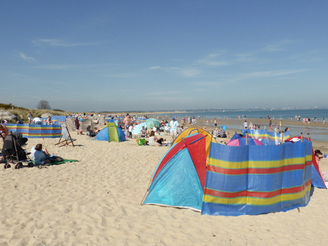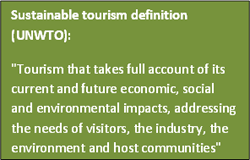'Overtourism': Fact, Fiction or Food for Thought?

"I think more has been written in mainstream press about issues associated with mass tourism in the past 6 weeks than in the past 6 years” (Justin Francis, CEO Responsible Tourism 16th Aug 2017: http://bit.ly/2uV8II7 )
A combination of the media ‘silly season’, main tourism season, and relentless tourism growth, resulted in a rash of ‘overtourism’ stories in the British media this summer.
So, is this just a case of media sensationalism? Or is it the canary in the mine of the global visitor economy, warning of impending disaster? Have we lost sight of the United Nations World Tourism Organization’s laudable exhortation to develop sustainable tourism? The truth is many destinations need fewer visitors in the peak season and more in the off-season. There are two sides to this coin.
The dream is disappearing for many visitors and the nightmare beginning for many destinations. The 'sharing economy' is becoming more about sharing less and less space with more and more people than any romantic notion of "what's mine is yours". Visiting the Sistine Chapel has become an exercise in self-preservation rather than artistic reflection; that backstreet cafe 'only the locals know about' is a fantasy; and, as for that idyllic deserted beach, forget about it.
Of course, there are exceptions. But the question is: “Are we reaching peak tourism?”
The answer varies from country to country, place to place, and season to season. But peak season congestion in many tourism hotspots worldwide is threatening to destroy not just the visitor experience, but also the natural and cultural environment.
Putting a Finger in the Dyke

Destinations are waking up to this for three reasons:
- Residents are becoming increasingly fed up with the impact of what they see as tourism congestion on their daily lives;
- The very thing that attracts visitors – the natural environment and built heritage – risks being irreparably damaged;
- If the visitor experience becomes intolerable, they will stay away, thus hitting the destination’s economy.
So, how are destinations responding?
Barcelona has placed a moratorium on new hotel building; Amsterdam is questioning whether it should halt promotion of the city; Venice is struggling to respond to residents clamouring to reclaim their ‘streets’; Bermuda, Mallorca and Ibiza have put a cap on hotel beds; Antarctica, the Galapagos and Dubrovnik have limited cruise ships; Machu Picchu has introduced a new permit system; Cambodia banned cars from Angkor Wat last year; Italy’s achingly picturesque Cinque Terre coastal villages have introduced a daily visitor quota; Florence’s Uffizi Gallery has introduced timed differential pricing to spread visitors; many attractions, sites and parks have put a limit on the number of visitors per day or year – from Beijing’s Forbidden City and New Zealand’s ‘Lord of the Rings’ Hobbiton village to Canadian National Parks; and, worldwide, countries and cities are toying with introducing or increasing tourism taxes. Cities, such as London, Paris, San Francisco and Reykjavik, have imposed a limit on short-term rental of entire houses and apartments (between 60 – 120 days), largely as a result of the success of platforms such as Airbnb. Nevertheless, 90 days still seems generous in a city like Reykjavik, where there is only one hotel room for every five visitors to the country and the informal rental market has distorted the property market, pricing local people out of homes.
Springing the Goose from Death Row
This is not a diatribe against the tourism sector – far from it. It is a plea to encourage governments, local authorities, national tourism offices (NTOs) and destination management organisations (DMOs) to think harder and plan more strategically, so that they do not kill the goose that lays the golden egg...........so that tourism can truly benefit their economy, reduce poverty, create jobs, enhance conservation, inspire tolerance, keep communities together, and underpin peace in troubled countries, as so many of us have preached for so long. Tourism can be a force for good, not least in developing economies. But, if not managed properly, it can be destructive of the natural environment, of cultural heritage, of host communities, and of residents’ goodwill.
The Solution: Managing, Not Just Creating, Growth
So, what’s the solution? In a nutshell, it’s long-term sustainable planning.
On the one hand a wide range of control mechanisms is available to destinations, from pricing, quotas and limits to regulations, licensing and investment freezes. But these require political will and a textured understanding of the visitor economy by local or national authorities. Placing restrictions on business growth is seldom a vote winner, unless growth has reached crisis proportions, as in the poster children for ‘overtourism’ such as Venice, Barcelona and Amsterdam.
On the other hand, there are several facilitative measures NTOs and DMOs can undertake without political sanction. But for too long, NTOs and DMOs have played a numbers game, often driven by their political masters: volume (visitor numbers) is easier to understand than value (revenue from visitors); it makes for a better media soundbite. In order to develop truly sustainable tourism, NTOs and DMOs should focus more consistently on:
- Spreading visitors throughout their country, thereby creating more jobs where they’re needed most;
- Attracting more visitors outside the main season, and thereby sustaining these jobs year-round;
- Targeting those visitors who will provide the greatest benefit to the destination, in terms of spend, length of stay, season of visit, propensity to travel beyond the ‘honeypots’, and, most importantly, their (responsible) behaviour in the destination.
Tourism ministries, NTOs and DMOs should also wake up to their broader responsibility and think about managing growth, not just creating it.
Social media has supplanted some of an NTO’s promotional role. Third party, user-generated recommendations are driving interest in places previously known only to a curious few – from the Isle of Skye’s Fairy Pools to Iceland’s Sólheimasandur beach and Spain’s Caminito del Rey. This should free up some resources to invest in managing growth, or at least more nuanced marketing.
Ideally, facilitative measures should go hand-in-hand with control mechanisms. Licensing, regulation, quotas and pricing can help moderate visitor flows to specific sites under pressure. But so too can better, more timely information, such as the helpful Cinque Terre app, which enables visitors to monitor traffic flows and check whether there is space for them that day. Such judicious combination of limiting access and empowering visitors to make their own decisions can both reduce congestion and improve profitability.
NTOs and DMOs can be smarter in using targeted, timely information to manage growth by time and place. The clever ones do. But more need to. Otherwise, “no vacancy” signs might be replaced by “visitors not welcome” messages…..or worse.
Ultimately, this is a test of true partnership between DMOs/NTOs, local/national authorities and businesses. Never has such partnership been more necessary. A sound destination management plan (DMP) is essential to enable places to attract the type of tourism communities want, rather than countenance limitless growth driven by promiscuous marketing.
Putting ‘Sustainable’ Back in ‘Development’
More momentously, continuing unfettered growth risks releasing a widespread backlash against tourism, which could threaten economic development and, with it, people's jobs. We need to start paying more than lip service to the ‘sustainable’ part of sustainable development.
The UNWTO showed admirable leadership when it nominated 2017 as the ‘International Year of Sustainable Tourism Development’. It’s time to call countries to account and ask what they’ve done differently this year in setting a path towards a more sustainable future for their destination. In short, it’s time to develop a strategy to protect tourism from itself. Otherwise we risk killing not just the clairvoyant canary, but the golden goose. We would do well, when planning our destination’s future, to ponder the words of Chinese philosopher, Lao Tzu: “He who knows that enough is enough will always have enough”.

